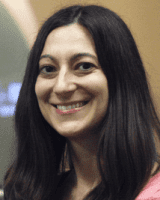The Federation of Associations in Behavioral & Brain Sciences (FABBS) Early Career Impact Award honors early-career scientists of FABBS member societies during the first 10 years post-PhD and recognizes scientists who have made major contributions to the sciences of mind, brain, and behavior. The goal is to enhance public visibility of these sciences and the research of the awardees.
VSS is asked to submit a nominee for the FABBS Early Career Impact Award every few years. VSS selects the nominee from among those who have been nominated for a VSS Young Investigator Award in the same year. The recipients of FABBS Early Career Impact Awards are:
2022 Recipient
 Radoslaw Cichy
Radoslaw Cichy
Professor of Neurocognitive and Experimental Psychology
Managing Director of the Center for Cognitive Neuroscience
Freie Universität Berlin.
Radoslaw Cichy is a cognitive and computational neuroscientist who studies how the brain allows us to perceive and recognize objects and scenes. He has developed innovative new computational approaches that combine the strengths of different ways of measuring brain function in humans (EEG; MEG; fMRI), while at the same time relating brain function to the ground truth of perceptual experience. His contributions include the development of M/EEG-fMRI “fusion” (2014, 2020). The central idea behind fusion is that even though different types of neural signals capture different aspects of the neural response (MEG or EEG are better at capturing changes over time, while fMRI is relatively slow, but has more spatial precision), it is nevertheless possible to mathematically exploit the similarities in how each type of signal responds to different experimental conditions to extract a composite picture of how visual signals are processed by different brain regions over time. Prof. Cichy has applied fusion to models of the neural representation of objects throughout the processing. In other work using deep neural network models, Cichy and colleagues (2019) showed that the evolution of neural signals in different brain regions over time reflected the role of both bottom-up and top-down (recurrent) processing. has published over 40 articles. Cichy’s work is supported by a German Emmy Noether award (1.2 Mill Euro) and an ERC Starting Grant (1.5 Mill Euro). He is also co-founder of the Argonauts Project, an “open challenge” to investigators to propose and test computational models of the brain’s response to objects. The Argonauts Project also is a novel and engaging approach to open science, where researchers share data and findings with each other and with the public.
2019 Recipient
 Julie Golomb
Julie Golomb
Associate Professor
Ohio State University
Julie Golomb earned her bachelor’s degree in neuroscience from Brandeis University and her doctorate from Yale University. She completed post-doctoral research at MIT before joining the faculty at Ohio State in 2012 and receiving tenure in 2018. Her lab’s research is funded by grants from the National Institutes of Health, the Alfred P. Sloan Foundation, and the Ohio Supercomputer Center. For more information about Dr. Golomb and an overview of her article, go to Making Sense from Dots of Light on the FABBS website.
